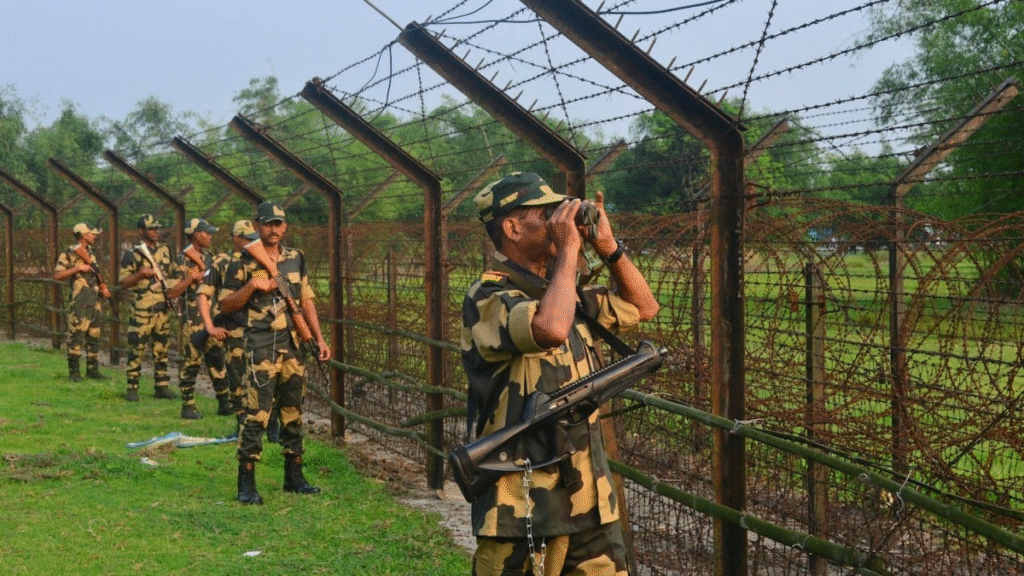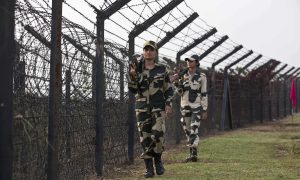
The India-Bangladesh border has historically been a place of vibrant cultural exchange, trade, and friendship between two nations sharing a long history and a porous boundary stretching over 4,000 kilometers. However, recent events at the Kurigram border area have highlighted ongoing complexities and the delicate balance required to manage such an extensive international frontier. This article explores the recent face-off between the Indian Border Security Force (BSF) and the Border Guard Bangladesh (BGB), unpacking the incident’s details, the broader historical and geopolitical context, and what it means for bilateral relations going forward.
The Kurigram Incident: What Happened?
The tension that erupted along the Kurigram border is not an isolated occurrence but rather part of a series of border disputes that have periodically flared up over decades. According to multiple sources, the recent standoff began when the BSF accused the BGB of allegedly “pushing in” individuals across the border, a term used to describe forcing people illegally into another country’s territory. The BSF claimed that these individuals were unauthorized migrants crossing into Indian soil, which sparked immediate concern given the longstanding challenges India faces regarding illegal immigration from Bangladesh.
On the other hand, the BGB countered these allegations, stating that the individuals in question were indeed Bangladeshi nationals who had accidentally crossed the border and were in the process of being returned home in accordance with bilateral protocols. The disagreement escalated, leading to a face-to-face confrontation between personnel of both forces, with each side positioning themselves firmly but refraining from physical violence.
Eyewitnesses and border officials have described a situation of heightened alert and mutual suspicion. The incident, while contained, raised alarms about the fragility of peace along this significant international boundary. Border communities on both sides watched anxiously as tensions simmered, concerned about the potential for escalation and the impact on their everyday lives.
The Geopolitical Significance of the India-Bangladesh Border
To understand the significance of the Kurigram incident, it is crucial to appreciate the historical and geopolitical importance of the India-Bangladesh border. Spanning over 4,096 kilometers, this border is among the longest in the world and cuts across diverse terrains—from rivers and forests to densely populated villages. The border area is home to millions who share cultural ties but are often divided by artificial boundaries drawn during the Partition of British India in 1947 and later refined after Bangladesh’s independence in 1971.
The India-Bangladesh border has witnessed several contentious issues including illegal immigration, smuggling, and occasional violence. At the same time, both countries have made strides to improve cooperation, especially after the 2015 Land Boundary Agreement (LBA), which resolved many longstanding disputes over enclaves and adverse possessions. This agreement was hailed as a major step forward, allowing thousands of people living in enclaves to choose their nationality and easing administrative challenges.
Despite these improvements, challenges remain. The border is porous in many areas, making it difficult to fully regulate the movement of people and goods. Illegal crossings, often driven by socio-economic factors such as poverty and lack of opportunity, continue to be a source of friction. The incident at Kurigram thus highlights the ongoing need for robust and nuanced border management.
A Closer Look at the “Push-In” Controversy
One of the most sensitive aspects of the recent Kurigram incident is the accusation of “push-in.” This term has been part of the dialogue surrounding India-Bangladesh border management for years and refers to the practice where border guards allegedly forcefully send back individuals across the boundary. While India has accused Bangladesh of using this tactic to push illegal immigrants into Indian territory, Bangladesh denies such claims, emphasizing cooperation and adherence to established protocols.
From the Indian perspective, illegal immigration from Bangladesh has been a longstanding concern. Various reports and political rhetoric have framed the influx as a challenge to national security and economic stability. Migrants often seek better opportunities in India, especially in bordering states like West Bengal, Assam, and Tripura. This movement can create demographic shifts, strain public resources, and occasionally heighten communal tensions.
Bangladesh, meanwhile, stresses that it neither supports illegal crossings nor condones any forceful pushbacks. In fact, the BGB has often highlighted its efforts to cooperate closely with the BSF to maintain border integrity. The confusion and mistrust between the two forces during the Kurigram incident seem to stem from ambiguities about individual identities and the circumstances of border crossing rather than intentional provocation.
Historical Tensions and Cooperation Along the Border
Historically, the India-Bangladesh border has been a source of both contention and collaboration. The two countries share a rich history of cultural, religious, and economic ties. Bangladesh’s liberation in 1971 was supported by India, creating a foundation for warm relations.
However, the border itself has been a thorny issue. The partition of British India created complex territorial arrangements, including enclaves—small pockets of one country’s territory surrounded by the other’s soil. These enclaves created confusion and hardship for residents for decades, until the 2015 LBA resolved most of these anomalies.
Still, illegal migration and smuggling have remained persistent challenges. Smuggling of goods like cattle, drugs, and fuel has thrived due to porous borders and economic disparities. These activities often lead to violent clashes between border forces trying to enforce the law. Moreover, political sensitivities about identity and security have sometimes fueled nationalist sentiments on both sides, complicating diplomatic efforts.
Despite these issues, India and Bangladesh have demonstrated remarkable resilience and willingness to engage in dialogue. High-level visits, joint border management initiatives, and cross-border connectivity projects have bolstered cooperation. The two nations share numerous agreements that regulate border protocols, movement of people, and trade.
The Human Impact: Border Communities Caught in the Middle
Beyond strategic and political implications, the Kurigram standoff deeply affects the lives of local residents. Border communities in this region are often poor and marginalized, relying heavily on cross-border trade and social connections for their livelihood.
Villagers living near the border are frequently caught between the conflicting priorities of security forces. Sudden border closures or heightened security disrupt daily life, affecting everything from farming activities to access to education and healthcare. In many cases, families are split by the border, with relatives living on opposite sides, complicating social and cultural ties.
The Kurigram incident, therefore, is more than just a military standoff; it is a reflection of the fragile realities faced by those who live in these border zones. Their stories often go unheard in broader diplomatic discussions but are vital to understanding the full impact of border tensions.
Diplomatic Responses and the Way Forward
The Kurigram border tension quickly became a subject of diplomatic concern in both India and Bangladesh. Officials from the Ministry of External Affairs in India and the Ministry of Foreign Affairs in Bangladesh issued statements underscoring the importance of maintaining peace and dialogue.
Bilateral diplomatic channels were activated to prevent escalation and to clarify misunderstandings. Both countries reiterated their commitment to resolving disputes through peaceful means and adhering to existing agreements. The importance of the Joint Border Coordination meetings and the use of hotline communications between border commanders was emphasized.
To reduce the risk of future conflicts, there is a strong case for expanding joint border patrols, improving communication protocols, and increasing transparency. Strengthening technological surveillance, including the use of drones and sensors, can help monitor unauthorized movements without unnecessary confrontations.
The Broader Geopolitical Context: Regional Stability and Cooperation
The Kurigram incident should also be viewed within the larger framework of South Asian geopolitics. The relationship between India and Bangladesh is a cornerstone of regional stability in the Bay of Bengal region.
India’s Act East policy and Bangladesh’s aspirations for economic growth through connectivity projects underscore the mutual benefits of a stable and secure border. Both countries are also members of regional bodies such as SAARC and BIMSTEC, which promote cooperation on trade, security, and cultural exchange.
Tensions at the border, if left unaddressed, can undermine these broader efforts and impact initiatives such as the India-Bangladesh Motor Vehicle Agreement and regional power grid cooperation. Therefore, resolving border issues promptly and comprehensively is essential not only for bilateral relations but also for the entire South Asian region.
Lessons Learned from the Kurigram Incident
The Kurigram standoff offers several important lessons for policymakers and border management agencies:
- Importance of Clear Protocols: Ambiguities in procedures for handling individuals crossing the border can lead to misunderstandings. Clear and jointly agreed protocols are essential.
- Communication is Key: Real-time communication between BSF and BGB units on the ground can prevent escalation.
- Focus on Humanitarian Aspects: Recognizing the plight of border residents and migrants is crucial. Cooperation should balance security concerns with humanitarian considerations.
- Leveraging Technology: Investing in modern border surveillance can reduce reliance on manpower-intensive patrolling and decrease friction.
- Political Will: Sustainable resolution requires commitment at the highest levels of government to prioritize peaceful coexistence over populist pressures.
Conclusion: Strengthening the India-Bangladesh Partnership
The incident at Kurigram is a reminder of the complexities inherent in managing one of the world’s longest and most intricate borders. While challenges persist, they also present opportunities for deeper collaboration, innovation, and mutual respect.
India and Bangladesh share a unique bond forged through shared history, culture, and aspirations for prosperity. The way forward lies in strengthening diplomatic ties, improving border management, and addressing root causes of migration and economic disparity.
By doing so, both countries can transform border challenges into opportunities for peace and progress, setting an example for neighboring countries and reaffirming their roles as responsible regional leaders.

